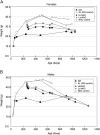Life extension by diet restriction and N-acetyl-L-cysteine in genetically heterogeneous mice
- PMID: 20819793
- PMCID: PMC2990268
- DOI: 10.1093/gerona/glq155
Life extension by diet restriction and N-acetyl-L-cysteine in genetically heterogeneous mice
Abstract
We used a heterogeneous stock of mice-UM-HET3, the first generation offspring of CByB6F1/J and C3D2F1/J parents-to test effects of six antiaging treatments on life span. In the first report of diet restriction in a structured, segregating heterogeneous population, we observed essentially the same increases in mean and maximum life span as found in CByB6F1/J hybrid positive controls. We also report results of treatment with N-acetyl-L-cysteine started at 7 months, and aspirin, nitroflurbiprofen, 4-hydroxy phenyl N-tert-butyl nitrone, and nordihydroguaiaretic acid, all started at 16-18 months. Only male UM-HET3 mice receiving N-acetyl-L-cysteine had significantly increased life span, and this may have been due to treatment-related inadvertent diet restriction. The other agents had no significant effects on life span. The use of UM-HET3 mice helps assure that these results are not the result of unresponsiveness of a single genotype but that they more broadly represent laboratory mice.
Figures





References
-
- Weindruch R, Masoro EJ. Concerns about rodent models for aging research. J Gerontol. 1991;46:B87–B88. - PubMed
-
- Flurkey K, Currer JM, Harrison DE. The mouse in aging research. In: Fox JG, Barthold SW, Davisson MT, Newcomer CE, Quimby FW, Smith AL, editors. The Mouse in Biomedical Research, Vol III. 2nd ed. Burlington, MA: Elsevier Academic Press; 2007. pp. 637–672.
-
- Austad SN. Issues in the choice of genetic configuration for animal aging models. Exp Gerontol. 1997;32:55–63. - PubMed
-
- Miller RA, Burke D, Nadon N. Announcement: four-way cross mouse stocks: a new, genetically heterogeneous resource for aging research. J Gerontol A Biol Sci Med Sci. 1999;54A:B358–B360. - PubMed
Publication types
MeSH terms
Substances
Grants and funding
LinkOut - more resources
Full Text Sources
Molecular Biology Databases

